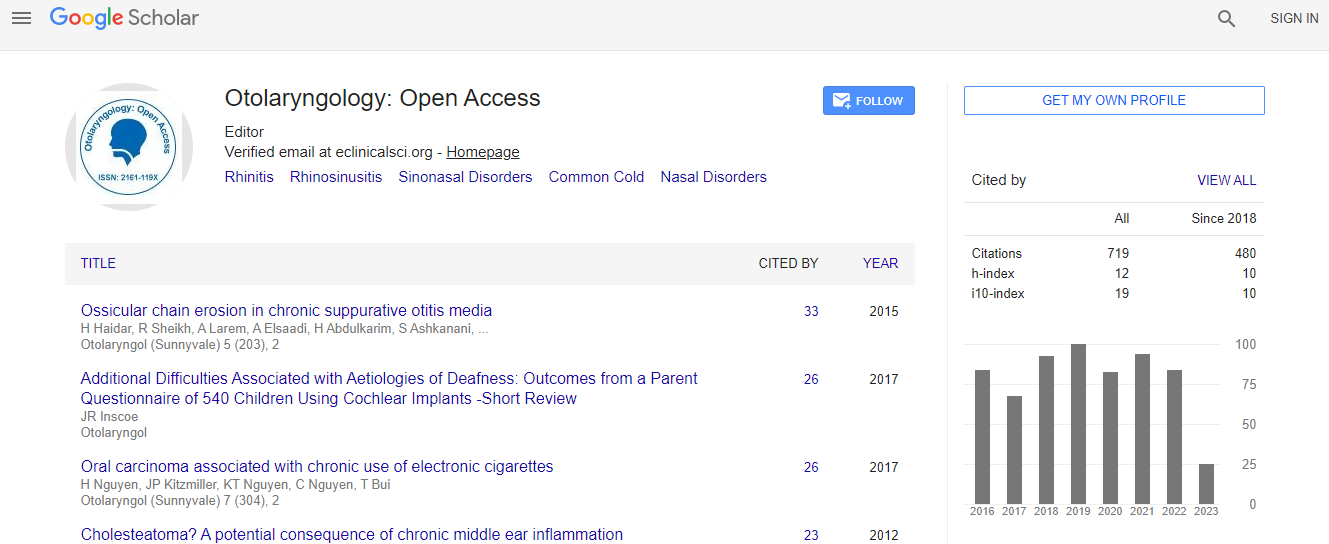Our Group organises 3000+ Global Conferenceseries Events every year across USA, Europe & Asia with support from 1000 more scientific Societies and Publishes 700+ Open Access Journals which contains over 50000 eminent personalities, reputed scientists as editorial board members.
Open Access Journals gaining more Readers and Citations
700 Journals and 15,000,000 Readers Each Journal is getting 25,000+ Readers
Google Scholar citation report
Citations : 925
Otolaryngology: Open Access received 925 citations as per Google Scholar report
Otolaryngology: Open Access peer review process verified at publons
Indexed In
- Index Copernicus
- Google Scholar
- Sherpa Romeo
- Open J Gate
- Genamics JournalSeek
- RefSeek
- Hamdard University
- EBSCO A-Z
- OCLC- WorldCat
- Publons
- Geneva Foundation for Medical Education and Research
- ICMJE
Useful Links
Recommended Journals
Related Subjects
Share This Page
The use of modified bespoke nasal splints to treat an infected pinna collection
International Conference on Aesthetic Medicine and ENT
Reshma Ghedia, Issa Beegun and Hesham Saleh
Charing Cross Hospital, UK
Posters & Accepted Abstracts: Otolaryngology
Abstract
Background: An infected pinna collection is a serious otological condition that can lead to cosmetic and audiological sequelae. They are often secondary to a piercing. Pseudomonas aeruginosa has been found to be the most common pathogen. There is no general consensus in the literature regarding management. The use of modified nasal splints has been described to treat a perichondria hematoma and we describe a similar technique to treat an infected pinna collection Technique: The ear should be prepared with appropriate antiseptic solutions and injected with Lignospan Special�® (2% Lidocaine hydrochloride with 2% Adrenaline 1: 80 000). A full-thickness 2-3cm skin incision should be made along the helical crease on the lateral aspect of the pinna. The pus must be irrigated with copious sodium chloride solution. Necrotic tissue should be debrided. The incision should not be closed. Exmoor�® nasal silicone splints should be cut to fit under the helix. These should be used to sandwich the pinna with the use of 3 non-absorbable monofilament mattress sutures to prevent further infection. We recommend the use of Jelonet �® in between to prevent excessive pressure. The patient should continue on anti-pseudomonal intravenous antibiotics until improvement is seen, when they can be converted to an appropriate oral equivalent. The patient should be reviewed in one week to remove the splints. We have had good outcomes for two patients treated this way at one month after the intervention Discussion: Modified nasal splints act as a mould by providing firm even pressure to the pinna thereby preventing recollection. This reduces fibrosis leading to a â��cauliflower earâ��. In addition the splints look clean throughout their use.Biography
Email: reshmaghedia@doctors.org.uk

 Spanish
Spanish  Chinese
Chinese  Russian
Russian  German
German  French
French  Japanese
Japanese  Portuguese
Portuguese  Hindi
Hindi 
